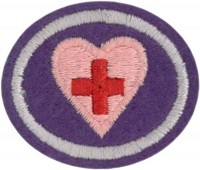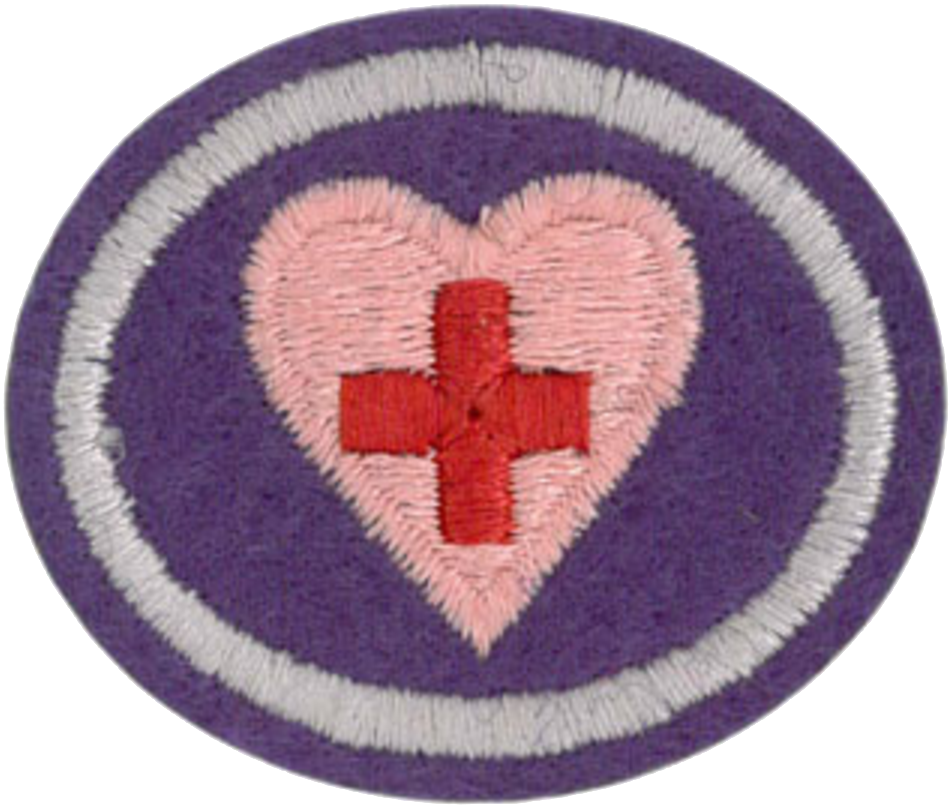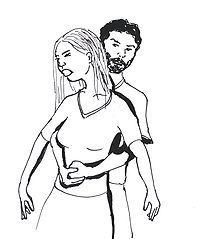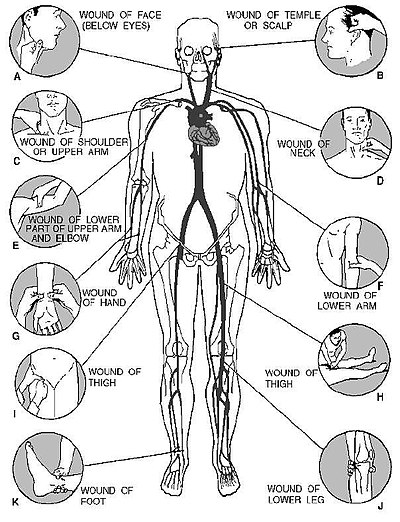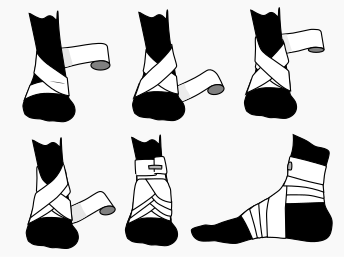Difference between revisions of "AY Honors/First Aid/Answer Key/es"
(Created page with "Un torniquete es un método de ''último recurso'' de control de la hemorragia. Otros métodos que deben ser aplicados primeramente y conjuntamente, si es posible, incluyen:") |
|||
| Line 163: | Line 163: | ||
<!-- 16. Saber cuándo y cómo utilizar correctamente un torniquete. Utilizando un gráfico, un maniquí u otro dispositivo de instrucción, demostrar dónde se encuentran los distintos puntos de presión en un cuerpo y cómo aplicar la presión correctamente. --> | <!-- 16. Saber cuándo y cómo utilizar correctamente un torniquete. Utilizando un gráfico, un maniquí u otro dispositivo de instrucción, demostrar dónde se encuentran los distintos puntos de presión en un cuerpo y cómo aplicar la presión correctamente. --> | ||
| − | + | Un '''torniquete''' es una banda fuertemente atada alrededor de una parte del cuerpo (un brazo o una pierna) que a veces se usa en un intento de detener el sangrado grave. El sangrado severo significa la pérdida de más de 1.000 ml (1 litro) de sangre. Este flujo de sangre puede empapar un paño en unos pocos segundos. En tal situación, el sangrado causará la muerte de la víctima de segundos a minutos. | |
| − | |||
| − | |||
| − | + | Un torniquete es un método de ''último recurso'' de control de la hemorragia. Otros métodos que deben ser aplicados primeramente y conjuntamente, si es posible, incluyen: | |
| − | |||
| − | |||
| − | + | * presión directa | |
| − | * | + | * elevar el miembro o la herida más alto que el corazón |
| − | * | + | * El uso de puntos de presión para hacer más lento la arteria por encima de la herida |
| − | * | + | * Los vendajes o agentes de coagulación sanguínea |
| − | * | ||
| − | |||
<div lang="en" dir="ltr" class="mw-content-ltr"> | <div lang="en" dir="ltr" class="mw-content-ltr"> | ||
Revision as of 15:13, 5 October 2023
Nivel de destreza
2
Año
1938
Version
20.05.2024
Autoridad de aprobación
División Norteamericana
Instructor requerido
1
Completar el requisito 2 Ó 3-29.
2
3
4
5
6
- La víctima no responde a la voz ni al tacto
- Confusión, nivel de conciencia
- Malestar en el pecho, posible ataque cardiaco
- Signos de derrame cerebral
- Problemas respiratorios
- Lesión o quemadura grave
- Hemorragia grave
- Convulsión
- Parálisis
- Envenenamiento de una parte del cuerpo
- Choque eléctrico
7
7a
7b
7c
8
8a
8b
La tos es la defensa natural del cuerpo contra la asfixia y es generalmente muy eficaz. Si la víctima está tosiendo, no interfiere. Si la víctima deja de toser (o nunca tosió), pregúntele: «¿Te estás ahogando o asfixiando?» Si la víctima indica que se está ahogando o asfixiando, dile que vas a ayudarla. Para hacer esto, tendrá que realizar la maniobra de Heimlich.
Adultos
Para realizar la acción en adultos es lo siguiente, con el sujeto de pie se debe abrazar al mismo por la espalda con los dos brazos. En esta posición se presiona con una mano cerrada y la otra recubriendo la primera. Se debe apoyar el puño con el pulgar sobre el abdomen y presionar hacia el centro del estómago, justo por encima del ombligo y bajo las costillas de la persona. En el caso de que el asfixiado se encuentre solo, debe tomar una silla con respaldo, cogerla por debajo del asiento, situarla por debajo de las costillas y empujar hacia arriba con fuerza, para conseguir expulsar el objeto asfixiante.
Niños mayores de dos años
Debe tenderse al pequeño boca arriba, encima de una superficie rígida. Apoyando las manos una encima de la otra, entre el esternón y el ombligo, se debe empujar varias veces en dirección al tórax. En niños mayores la maniobra puede realizarse como en los adultos. Es muy efectiva. La maniobra de Heimlich también es aconsejable en niños mayores de dos años.
Aun cuando se realiza correctamente, la maniobra de Heimlich puede lastimar a la persona. La maniobra de Heimlich nunca se debe realizar en alguien que todavía puede toser, respirar o hablar. No debe demostrar o practicar en una persona sana y no ahogándose o asfixiándose.
8c
9
10
Un ataque al corazón es cuando el suministro de sangre a una parte del corazón se interrumpe causando el tejido del corazón a morir. Los síntomas de un ataque al corazón incluyen dolor severo en el pecho, con un aspecto pálido, sudoroso y sensaciones de mareo. Un ataque al corazón es una emergencia médica y es la causa principal de muerte tanto en hombres como en mujeres.
Primeros auxilios incluyen lo siguiente:
- Busque asistencia médica de emergencia inmediatamente.
- Ayude a la víctima a descansar en una posición que minimiza las dificultades de respiración. Usualmente se recomienda una posición media-sentado con las rodillas flexionadas.
- Dé acceso a más oxígeno, por ejemplo, abrir una ventana y ampliar el cuello de la camisa para facilitar la respiración; pero mantenga a la víctima caliente, con una manta o una chaqueta.
- Dé aspirina, si la víctima no es alérgica. La aspirina inhibe la formación de nuevos coágulos de sangre.
- Son preferibles las pastillas solubles. Estos deben ser masticadas o disueltas, respectivamente, para facilitar la absorción más rápida. Si la víctima no puede tragar, la aspirina se puede colocar bajo la lengua.
- Directrices estadounidenses recomiendan una dosis de 160 a 325 mg.
- Directrices australianas recomiendan una dosis de 150 a 300 mg.
- Si se ha prescrito para la víctima, dé tabletas de nitroglicerina debajo de la lengua.
- Monitoree el pulso, la respiración, el nivel de conciencia y, si es posible, la presión arterial de la víctima continuamente.
- Administre RCP si la víctima está inconsciente y no respira.
11
El desmayo es una forma temporal de auto-corrección del choque. Usualmente es el resultado de una acumulación temporal gravitacional de la sangre mientras una persona se pone de pie. Mientras la persona se cae, la sangre corre de nuevo a la cabeza y el problema se resuelve. Generalmente, los problemas graves relacionados con desmayos son heridas que se producen al caer de la pérdida temporal de la conciencia. El desmayo puede ser causado por situaciones de estrés.
Si una persona se desmaya (o se siente que está a punto de desmayarse) haga lo siguiente:
- Acueste a la víctima
- Eleve a los pies
- Afloje la ropa apretada
- Mantenga una vía respiratoria abierta
12
13
Un accidente cerebrovascular es causado por una interrupción del suministro de sangre arterial a una parte del cerebro. Esta interrupción puede ser causada por el endurecimiento de las arterias o mediante la formación de un coágulo en el cerebro. El daño tisular y la pérdida del funcionamiento generalmente resultan. Un ataque de un derrame cerebral es repentino, con poco o ningún aviso. Los primeros síntomas incluyen debilidad o parálisis, especialmente en un lado del cuerpo. Los músculos de la cara pueden verse particularmente afectadas. El nivel de conciencia de la víctima varía de alerta a no poder responder. La dificultad de hablar o entender el lenguaje; mareos; dolor de cabeza repentino y severo; visión débil, distorsionada o irregular son síntomas de un derrame cerebral.
Si la víctima tiene un ataque de cualquier 2 o más de estos síntomas, llame a una ambulancia inmediatamente. Primeros auxilios para un derrame cerebral es principalmente de apoyo. Atención especial se debe prestar a las vías respiratorias de la víctima, ya que no puede ser capaz de mantenerlas desobstruidas.
- Llame a una ambulancia
- Coloque la víctima en su lado, con el lado afectado hacia abajo
- Actúe de una manera tranquila y tranquilizadora y mantenga a cualquiera espectador tranquilo ya que la víctima puede ser capaz de escuchar lo que está pasando.
- Supervisar cuidadosamente los signos vitales de la víctima y mantener un registro. Preste atención especialmente a la respiración, y la fuerza y la velocidad del pulso (tome el pulso en el cuello).
14
15
Si ve a una persona que está sangrando mucho, puede hacer lo siguiente:
- Presione duro sobre la herida para detener el sangrado.
- Si se corta un brazo o una pierna, eleve el miembro.
- Cubra con una almohadilla limpia y ponga un vendaje.
- Verifique que el sangrado se ha detenido. Si no es así, puede añadir otra almohadilla y otro vendaje; no quite el vendaje anterior.
- Si ha vendado una extremidad, verifique frecuentemente que los dedos de la mano y dedos de los pies se mantienen cálidos. Si los dedos se están enfriando, afloje el vendaje para que la sangre circule.
- Para un sangrado severo (5 tazas de sangre o más), lleve a la persona a un hospital para recibir puntos de sutura (y posiblemente una inmunización contra el tétano) y mantenga la extremidad elevada.
16
Un torniquete es una banda fuertemente atada alrededor de una parte del cuerpo (un brazo o una pierna) que a veces se usa en un intento de detener el sangrado grave. El sangrado severo significa la pérdida de más de 1.000 ml (1 litro) de sangre. Este flujo de sangre puede empapar un paño en unos pocos segundos. En tal situación, el sangrado causará la muerte de la víctima de segundos a minutos.
Un torniquete es un método de último recurso de control de la hemorragia. Otros métodos que deben ser aplicados primeramente y conjuntamente, si es posible, incluyen:
- presión directa
- elevar el miembro o la herida más alto que el corazón
- El uso de puntos de presión para hacer más lento la arteria por encima de la herida
- Los vendajes o agentes de coagulación sanguínea
Even in cases of amputation, most bleeding can be controlled through these alternative methods. The rare exception is when a limb is shattered by massive trauma or when a major blood vessel is torn along its length. Even in these cases, the use of a pressure point above the wound is strongly preferred.
As the tourniquet stops blood flow to the limb, it can cause the death of the limb, forcing the later surgical amputation of the limb just below the level the tourniquet is applied. This is likely to occur when the tourniquet stays in place several hours. In any event, once a tourniquet has been applied, advanced medical care from a doctor or hospital will be required to salvage the limb if not save the life of the patient.
The decision to employ a tourniquet should be made by an emergency medical technician or preferably a doctor if at all possible. But when severe external bleeding cannot be controlled by other means, a tourniquet may be the only way for a first-aider to save the casualty.
Most civilian first aid instruction in the United States no longer teaches the use of the tourniquet for the following reasons:
- the effectiveness of direct pressure, elevation and pressure points (controlling severe bleeding in up to 90% of cases as estimated by US medical sources)
- the increased difficulty of reattaching an amputated limb when a tourniquet has been applied to the victim
- unnecessary use by poorly trained bystanders
- the unavoidable risks to both limb and life even when properly employed
- the rare nature of injuries that require tourniquets, which typically occur in unusual settings such as working with agricultural or industrial machinery and the battlefield
The use of a tourniquet by a layperson in countries where it is considered outside the scope of practice of first aid may result in civil lawsuits and/or criminal charges, especially if the application was later found to have been unnecessary.
The usual way to control bleeding is to put pressure directly onto the wound, either with the hand directly or with a dressing of some sort (bandage, handkerchief, tea towel etc.). Do not forget that any wound which is not controlled within a minute or two is a medical emergency; and any deep or large wound must receive medical attention as soon as possible.
It is sometimes not possible to press directly on a wound: for example, there may be a foreign object inside the wound, or a broken bone protruding outside, or the wound may be too large or be inaccessible (e.g. if the limb is trapped by some immovable object). In this case, the only way to control the bleeding is to compress blood vessels over particular pressure points (usually where arteries cross over bones near to the surface of the skin). This technique can be used to control external bleeding from arm wounds and leg wounds.
The correct point is determined by finding a pulse on a victim similar to that felt in the wrist when taking one's own pulse. This point could be located in the wrist, the arm (on the soft underside of the elbow), the groin, or behind the knee. This is the position where a rhythmical pulsation can be felt. Pressure can then be applied over this point -- the artery -- to control bleeding.
Once an artery is compressed over a pressure point, it must not be compressed for more than 10 minutes: any longer in one go can cause irreversible damage to the limb. Typically pressure would be applied for 10 minutes, then released for a couple, then reapplied and so on.
17
18
18a
18b
18c
19
20
21
22
23
23a
23b
The figure-eight bandage can also be used on the hand, wrist, elbow, and knee.
23c
23d
23e
23f
There are two long bones in the forearm, the radius and the ulna. When both are broken, the arm usually appears to be deformed. When only one is broken, the other acts as a splint and the arm retains a more or less natural appearance. Any fracture of the forearm is likely to result in pain, tenderness, inability to use the forearm, and a kind of wobbly motion at the point of injury. If the fracture is open, a bone will show through. If the fracture is open, stop the bleeding and treat the wound. Apply a sterile dressing over the wound. Carefully straighten the forearm. (Remember that rough handling of a closed fracture may turn it into an open fracture.) Apply two well-padded splints to the forearm, one on the top and one on the bottom. Be sure that the splints are long enough to extend from the elbow to the wrist. Use bandages to hold the splints in place. Put the forearm across the chest. The palm of the hand should be turned in, with the thumb pointing upward. Support the forearm in this position by means of a wide sling and a cravat bandage (see illustration). The hand should be raised about 4 inches above the level of the elbow. Treat the victim for shock and evacuate as soon as possible.
23g
The figure-eight bandage is used for dressings of the ankle, as well as for supporting a sprain. While keeping the foot at a right angle, start a 3-inch bandage around the instep for several turns to anchor it. Carry the bandage upward over the instep and around behind the ankle, forward, and again across the instep and down under the arch, thus completing one figure-eight. Continue the figure-eight turns, overlapping one-third to one-half the width of the bandage and with an occasional turn around the ankle, until the compress is secured or until adequate support is obtained.
23h
24
For chemical burns:
1. For wet chemicals, immediately flush the area with large amounts of water, using a shower or hose, if available. Do not apply water too forcefully. Continue to flood the area while the clothing, including shoes and socks, is being removed. Continue to flush with running water for at least 20 minutes.
- For dry chemicals, brush off the chemical, then flush with water as above.
- For acid burns caused by phenol (carbolic acid), wash the affected area with alcohol because phenol is not water soluble; then wash with water. If alcohol is not available, flushing with water is better than no treatment at all.
2. Call an ambulance
25
26
27
Heat Exhaustion
Heat exhaustion is the most common condition caused by working or exercising in hot spaces. Heat exhaustion produces a serious disruption of blood flow to the brain, heart, and lungs. This causes the victim to experience weakness, dizziness, headache, loss of appetite, and nausea.
Signs and symptoms of heat exhaustion are similar to those of shock: the victim will appear ashen gray; the skin will be cold, moist, and clammy; and the pupils of the eyes may be dilated (enlarged). The vital (blood pressure, temperature, pulse, and respiration) signs usually are normal; however, the victim may have a weak pulse together with rapid and shallow breathing.
Body temperature may be below normal. You should treat heat exhaustion victims as if they were in shock. Loosen the clothing, apply cool wet cloths, move the victim to either a cool or an air-conditioned area, and fan the victim. Do not allow the person to become chilled. If the victim is conscious, administer a solution of 1 teaspoon of salt dissolved in a quart of cool water. If the victim vomits, do not give any more fluids. Transport the victim to a medical facility as soon as possible.
Hypothermia
Hypothermia is caused by continued exposure to low or rapidly falling temperatures, cold moisture, snow, or ice. Those exposed to low temperatures for extended periods may suffer ill effects, even if they are well protected by clothing, because cold affects the body systems slowly, almost without notice. As the body cools, there are several stages of progressive discomfort and disability. he first symptom is shivering, which is an attempt to generate heat by repeated contractions of surface muscles. This is followed by a feeling of listlessness, indifference, and drowsiness. Unconsciousness can follow quickly. Shock becomes evident as the victim’s eyes assume a glassy stare, respiration becomes slow and shallow, and the pulse is weak or absent. As the body temperature drops even lower, peripheral circulation decreases and the extremities become susceptible to freezing. Finally, death results as the core temperature of the body approaches 80°F (27°C). The steps for treatment of hypothermia are as follows:
- Carefully observe respiratory effort and heart beat; CPR may be required while the warming process is underway.
- Rewarm the victim as soon as possible. It may be necessary to treat other injuries before the victim can be moved to a warmer place. Severe bleeding must be controlled and fractures splinted over clothing before the victim is moved.
- Replace wet or frozen clothing and remove anything that constricts the victim’s arms, legs, or fingers, interfering with circulation.
- If the victim is inside a warm place and is conscious, the most effective method of warming is immersion in a tub of warm (100° to 105°F or 38° to 41°C) water. The water should be warm to the elbow - never hot. Observe closely for signs of respiratory failure and cardiac arrest (rewarming shock). Rewarming shock can be minimized by warming the body trunk before the limbs to prevent vasodilation in the extremities with subsequent shock due to blood volume shifts.
- If a tub is not available, apply external heat to both sides of the victim. Natural body heat (skin to skin) from two rescuers is the best method. This is called “buddy warming.” If this is not practical, use hot water bottles or an electric rewarming blanket. Do not place the blanket or bottles next to bare skin, however, and be careful to monitor the temperature of the artificial heat source, since the victim is very susceptible to burn injury. Because the victim is unable to generate adequate body heat, placement under a blanket or in a sleeping bag is not sufficient treatment.
- If the victim is conscious, give warm liquids to drink. Never give alcoholic beverages or allow the victim to smoke.
- Dry the victim thoroughly if water is used for rewarming.
- As soon as possible, transfer the victim to a definitive care facility. Be alert for the signs of respiratory and cardiac arrest during transfer, and keep the victim warm.
Frostbite
Frostbite occurs when ice crystals form in the skin or deeper tissues after exposure to a temperature of 32°F (0°C) or lower. Depending upon the temperature, altitude, and wind speed, the exposure time necessary to produce frostbite varies from a few minutes to several hours.
The areas most commonly affected are the face and extremities. The symptoms of frostbite are progressive. Victims generally incur this injury without being acutely aware of it. Initially, the affected skin reddens and there is an uncomfortable coldness. With continued heat loss, there is a numbness of the affected area due to reduced circulation. As ice crystals form, the frozen extremity appears white, yellow-white, or mottled blue-white, and is cold, hard, and insensitive to touch or pressure. Frostbite is classified as superficial or deep, depending on the extent of tissue involvement.
Superficial Frostbite
In superficial frostbite the surface of the skin will feel hard or rubbery, but the underlying tissue will be soft, allowing it to move over bony ridges. On the exposed skin on the neck and face it is common to first notice patches that are white or waxy in appearance. This is evidence that only the skin and the region just below it are involved. Very little information is available in wilderness first aid training on the appearance of mid and dark toned skin that has been exposed to mild or superficial frostbite. General treatment for superficial frostbite is as follows:
- Take the victim indoors, or at a minimum, increase their shelter from the elements.
- Superficial frostbite around the head can typically be reversed quickly by sheltering from the elements with a scarf, hat, or even a gloved hand.
- Rewarm hands by placing them under the armpits, against the abdomen, or between the legs.
- Rewarm feet by placing them in the armpit or against the abdomen of the buddy.
- Gradually rewarm the affected area by warm water immersion, skin-to-skin contact, or hot water bottles.
- Place hot water bottles into a dry sock/glove to avoid overheating skin.
- Never rub a frostbite area.
Deep Frostbite
In deep frostbite, the freezing reaches into the deep tissue layers. There are ice crystals in the entire thickness of the extremity. The skin will not move over bony ridges and will feel hard and solid. The objectives of treatment are to protect the frozen areas from further injury, to rapidly thaw the affected area, and to be prepared to respond to circulatory or respiratory difficulties.
- Carefully assess and treat any other injuries first. Constantly monitor the victim’s pulse and breathing since respiratory and heart problems can develop rapidly. Be prepared to administer CPR if necessary.
- Do not attempt to thaw the frostbitten area if there is a possibility of refreezing. It is better to leave the part frozen until the victim arrives at a medical treatment facility equipped for long-term care. Refreezing of a thawed extremity causes severe and disabling damage.
- Treat all victims with injuries to the feet or legs as litter patients. When this is not possible, the victim may walk on the frozen limb, since it has been proven that walking will not lessen the chances of successful treatment as long as the limb has not thawed out.
- When adequate protection from further cold exposure is available, prepare the victim for rewarming by removing all constricting clothing such as gloves, boots, and socks. Boots and clothing frozen on the body should be thawed by warm-water immersion before removal.
- Rapidly rewarm frozen areas by immersion in water at 100°F to 105°F (38°C to 41°C). Keep the water warm by adding fresh hot water, but do not pour the water directly on the injured area. Ensure that the frozen area is completely surrounded by water; do not let it rest on the side or bottom of the tub.
- After rewarming has been completed, pat the area dry with a soft towel. Later it will swell, sting, and burn. Blisters may develop. These should be protected from breaking. Avoid pressure, rubbing, or constriction of the injured area. Keep the skin dry with sterile dressings and place cotton between the toes and fingers to prevent their sticking together.
- Protect the tissue from additional injury and keep it as clean as possible (use sterile dressings and linen).
- Try to improve the general morale and comfort of the victim by giving hot, stimulating fluids such as tea or coffee. Do not allow the victim to smoke or use alcoholic beverages while being treated.
- Transfer to a medical treatment facility as soon as possible. During transportation, slightly elevate the frostbitten area and keep the victim and the injured area warm. Do not allow the injured area to be exposed to the cold.
28
29
29a
29b
29c
29d
29e
29f
29g
Nota: Ya sea que se obtenga la certificación o se completen los requisitos enumerados anteriormente, cada joven que aprenda primeros auxilios en este nivel debe saber dónde se guarda el botiquín de primeros auxilios del club, la escuela y/o la iglesia y cómo utilizarlo. Todos los botiquines de primeros auxilios deben incluir guantes y protección para los ojos junto con los suministros regulares.
References
